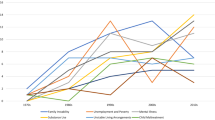Abstract
We identified correlates of unsheltered status among Veterans experiencing homelessness and described distinct subgroups within the unsheltered homeless Veteran population using data from a screening instrument for homelessness that is administered to all Veterans accessing outpatient care at a Veterans Health Administration (VHA) facility. Correlates of unsheltered homelessness included male gender, white race, older age, lower levels of VHA eligibility, substance use disorders, frequent use of VHA inpatient and infrequent use of VHA outpatient services, and residing in the West. We identified six distinct subgroups of unsheltered Veterans; the tri-morbid frequent users represented the highest need group, but the largest group was comprised of Veterans who made highly infrequent use of VHA healthcare services. Differences between sheltered and unsheltered Veterans and heterogeneity within the unsheltered Veteran population should be considered in targeting housing and other interventions.
Similar content being viewed by others
References
Bates, D., Maechler, M., Bolker, B., & Walker, S. (2014). lme4: Linear mixed-effects models using Eigen and S4. Journal of Statistiscal Software.
Cousineau, M. R. (1997). Health status of and access to health services by residents of urban encampments in Los Angeles. Journal of Health Care for the Poor and Underserved, 8(1), 70–82. doi:10.1353/hpu.2010.0378.
Early, D. W. (2005). An empirical investigation of the determinants of street homelessness. Journal of Housing Economics, 14(1), 27–47. doi:10.1016/j.jhe.2005.03.001.
Elixhauser, A., Steiner, C., Harris, D. R., & Coffey, R. M. (1998). Comorbidity measures for use with administrative data. Medical Care, 36(1), 8–27.
Fihn, S. D., Francis, J., Clancy, C., Nielson, C., Nelson, K., Rumsfeld, J., & Graham, G. L. (2014). Insights from advanced analytics at the Veterans Health Administration. Health Affairs, 33(7), 1203–1211. doi:10.1377/hlthaff.2014.0054.
Gelberg, L., & Linn, L. S. (1989). Assessing the physical health of homeless adults. JAMA: The Journal of the American Medical Association, 262(14), 1973. doi:10.1001/jama.1989.03430140091031.
Kushel, M. B., Perry, S., Bangsberg, D., Clark, R., & Moss, A. R. (2002). Emergency department use among the homeless and marginally housed: Results from a community-based study. American Journal of Public Health, 92(5), 778–784.
Lam, J., & Rosenheck, R. (1999). Street outreach for homeless persons with serious mental illness: Is it effective? Medical Care, 37(9), 894–907.
Larsen, L., Poortinga, E., & Hurdle, D. E. (2004). Sleeping rough: Exploring the differences between shelter-using and non-shelter-using homeless individuals. Environment and Behavior, 36(4), 578–591. doi:10.1177/0013916503261385.
Levitt, A. J., Culhane, D. P., DeGenova, J., O’Quinn, P., & Bainbridge, J. (2009). Health and social characteristics of homeless adults in Manhattan who were chronically or not chronically unsheltered. Psychiatric Service, 60(7), 978–981. doi:10.1176/appi.ps.60.7.978.
Linzer, D., & Lewis, J. (2011). poLCA: An R package for polytomous variable latent class analysis. Journal of Statistiscal Software, 42(10), 1–29.
McCutcheon, A. L. (1987). Latent class analysis. Newbury Park, CA: SAGE Publications Inc.
Montgomery, A. E., Hill, L. L., Kane, V., & Culhane, D. P. (2013). Housing chronically homeless veterans: Evaluation the efficacy of a housing first approach to HUD-VASH. Journal of Community Psychology, 41(4), 505–514. doi:10.1002/jcop.21554.
Nyamathi, A. M., Leake, B., & Gelberg, L. (2000). Sheltered versus nonsheltered homeless women. Journal of General Internal Medicine, 15(8), 565–572. doi:10.1046/j.1525-1497.2000.07007.x.
O’Toole, T. P., Gibbon, J. L., Hanusa, B. H., & Fine, M. J. (1999). Utilization of health care services among subgroups of urban homeless and housed poor. Journal of Health Politics, Policy and Law, 24(1), 91–114. doi:10.1215/03616878-24-1-91.
R Core Development Team. (2015). R: A language and environment for statistical computing. Retrieved May 18, 2015, from http://www.r-project.org.
Reid, K. W., Vittinghoff, E., & Kushel, M. B. (2008). Association between the level of housing instability, economic standing and health care access: A meta-regression. Journal of Health Care for the Poor and Underserved, 19(4), 1212–1228.
Shern, D. L., Tsemberis, S., Anthony, W., Lovell, A. M., Richmond, L., Felton, C. J., et al. (2000). Serving street-dwelling individuals with psychiatric disabilities: Outcomes of a psychiatric rehabilitation clinical trial. American Journal of Public Health, 90(12), 1873–1878.
Tsai, J., Kasprow, W. J., Kane, V., & Rosenheck, R. A. (2014). Street outreach and other forms of engagement with literally homeless veterans. Journal of Health Care for the Poor and Underserved, 25(2), 694–704. doi:10.1353/hpu.2014.0087.
U.S. Census Bureau. (2013). Geographic terms and concepts—Census divisions and census regions. Retrieved from https://www.census.gov/geo/reference/gtc/gtc_census_divreg.html.
U.S. Department of Housing and Urban Development. (2014). The 2014 annual homelessness assessment report to congress, part 1: Point-in-time estimates of homelessness. Washington, DC: Author.
U.S. Department of Veterans Affairs Veteran Support Service Center. (2014). Clinical inventory facility programs/demographics report. Retrieved April 6, 2014, from http://reports2.vssc.med.va.gov/ReportServer/.
Author information
Authors and Affiliations
Corresponding author
Additional information
The contents of this article do not necessarily represent the views of the Department of Veterans Affairs or the United States Government.
Rights and permissions
About this article
Cite this article
Byrne, T., Montgomery, A.E. & Fargo, J.D. Unsheltered Homelessness Among Veterans: Correlates and Profiles. Community Ment Health J 52, 148–157 (2016). https://doi.org/10.1007/s10597-015-9922-0
Received:
Accepted:
Published:
Issue Date:
DOI: https://doi.org/10.1007/s10597-015-9922-0




